Pubs and inns in Buxton
The pubs and inns in Buxton are an important part of the historical character of the town of Buxton, Derbyshire, in England. The inns date back to the 16th century and several are listed buildings. Most are within the Conservation Areas of Higher Buxton, Central Buxton and Fairfield.[1][2]
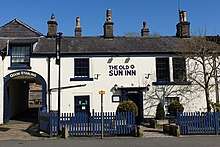
Pubs and inns by district
Higher Buxton
The Old Sun Inn (formerly The Sun and The Rising Sun) is one of the oldest buildings in Buxton and was built in the 17th century as a coaching inn. The arch on the passageway to the rear coachyard has 'Good Stabling' inscribed on it. The inn is set back from the High Street so that coaches could pull up outside it to allow travellers to step off. Inside there is an old small 'courting' room, where parents could observe a courting couple through windows on either side. The interior has stone floors and oak panelling. It is a Grade II listed building and it is now a free house.[3][4]
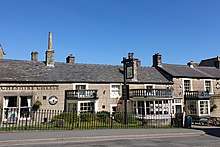
The Cheshire Cheese is a two-storey stone building from at least 1787 and is also set back from the High Street. It is a Grade II listed building, including its ornate iron railings with fleur-de-lys, urns and acorns design. It was once owned by Samuel Mycock who built Solomon's Temple on Grinlow hill. It is now run by Titanic Brewery.[5]
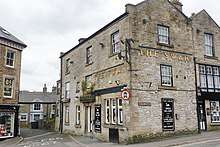
The Swan (known also as the White Swan and formerly known as The Shoulder of Mutton) is a two-storey stone building on the corner of Church Street and Bath Street. It was built as a coaching house before 1811. In about 1850 the inn was boycotted after a soldier was accused by the landlord of not paying for his drink, tied to a tree and flogged. It is a Grade II listed building and is now a free house.[4][6][7]
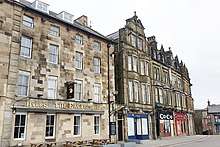
The Eagle on the Market Place was built in 1760 by the 4th Duke of Devonshire as a Georgian spa hotel. The four-storey building replaced the earlier Eagle and Child Inn on the same site from 1592. This coaching inn was the dinner stop for the London to Manchester coaches. It was known briefly from 1903 as the Devonshire Hotel. It is currently operated by Hydes Brewery.[8][9][10]
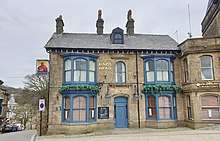
The Kings Head is on the Market Place next to the Buxton Town Hall. It was originally built in 1725 as a parsonage.[11] It is now run by Martson's Brewery. On the outside wall, there is a plaque marking the start and finish of the Peak District Boundary Walk (a circular 190-mile (310 km) walking trail).
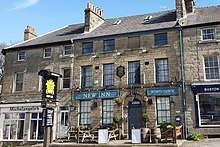
The New Inn on the Market Place is a three-storey millstone grit building from around 1800. It was originally known as the New Sun Hotel and in the late 1840s as the New Inn and Yorkshire Commercial Hotel. It has been run by Robinsons Brewery since 1838.[12]
The Queen's Head Hotel is a two- and three-storey building on High Street.
Other bars in Higher Buxton are 53 Degrees North, the Ale Stop, the Vault, the Pickled Frog and South 16.
The Blazing Rag and London Road Inn are both on London Road.
Central Buxton
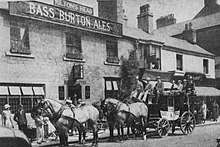
The Milton's Head (named after the 17th-century poet John Milton) is a simple stone building on Spring Gardens dating from the early 19th century.
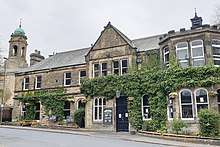
The Old Clubhouse is a two-storey stone building on Water Street, opposite the Buxton Opera House. The Union Club was built in 1886 (designed by architect William Radford Bryden) as a gentleman's club for guests to the spa town. It is a Grade II listed building and is now run by Greene King brewery.[9][13]
The Railway Hotel was built on Bridge Street (in front of the railway viaduct) for the Chesterfield Brewery Company in 1864. It is now operated by Joseph Holt's Brewery.[9]
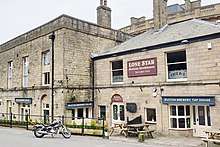
The Buxton Brewery Tap House is on George Street in the Old Courthouse buildings, which date from the mid-19th century (and were previously used as council offices and as Oram's car showrooms in the mid-20th century). Buxton Brewery started operations in 2009.[8]

The Red Willow bar is located in the old William & Glynns Bank (later RBS Bank) building on Cavendish Circus. It was opened in 2018 by Macclesfield's Red Willow Brewery.[9]
Monk's Bar is also on Cavendish Circus.
Fairfield
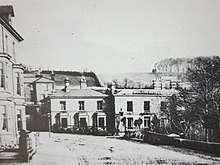
Wye Bridge House on Fairfield Road was originally a private residence by the River Wye. It became the Midland Hotel after the arrival of the railways in the 1863. It was called the Ashwood Park Hotel after Buxton Corporation bought it in 1921 during their redevelopment of Ashwood Park. It is now run by Wetherspoons.[14]
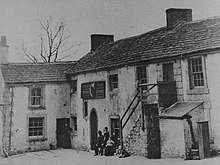
The Bull's Head is a three-storey stone building on Fairfield Road which replaced the previous one which was demolished in 1903.[15]
The 19th Hole pub on Waterswallows Road is close to the 18th green of the Buxton and High Peak Golf Club. It is run by Martson's Brewery.
Burbage
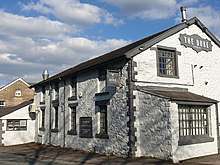
The Duke (formerly the Duke of York Inn) on St John's Road is an old two-storey stone building. It is a free house.
Harpur Hill
The Parks Inn was built in the 1800s and was refurbished in 2019. It is owned by the Heinken-owned Star Pubs and Bars.[16]
Pubs of the past

The Angel from at least 1773 was demolished in 1849 when the Royal Hotel was built on Spring Gardens. The Baker's Arms at 26 West Road closed in 2008 and was converted into two houses called Bakers Cottages. It is the oldest building on its side of the road, with a mansard roof added later.
The George Hotel was built as a Georgian spa hotel in about 1770 on George Street. It was bought by the Duke of Devonshire in 1806. American ex-president Thomas Jefferson once stayed at The George. Much of the hotel was converted to the George Mansions apartments. The remaining George Inn closed in 2007.[1][4]
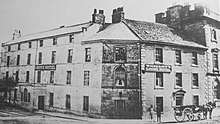
The Grove Inn on the corner of Spring Gardens and Manchester Road became the Grove Hotel and was operated by Robinsons Brewery before being closed. The building is now empty.[15]

The Royal Oak inn (recorded in 1857) at Nithen on Manchester Road is now a farmhouse. The Shakespeare was built in 1711 on Tideswell Lane (now Spring Gardens) but it was converted to shops in 1926. The Wheatsheaf Inn was behind The Swan on Church Street. The White Hart coaching inn was in Scarsbrick Place since before 1752. It was the breakfast stop for the Manchester to London coaches. It was renamed as The Scarsdale Arms in 1796 but was closed by1802 and was converted into 3 houses.[15]
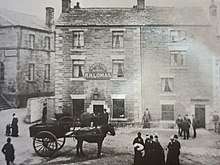
The White Lion was built in 1798 as a carrier's inn on Tideswell Lane (now Spring Gardens). Traders set themselves up in the cobbled yard and used it as a base for transporting their goods. It was briefly known as the Marquis of Hartington's Arms. Marston's Brewery ran the pub before it closed in 2011. The White Lion and its adjoining stable block are Grade II listed buildings.[17][4]
There are also historical records of other public houses: the Cheshire Cheese (on Macclesfield Old Road in 1842), the Fountain (on High Street in 1850s), the Fox and Hounds (on West Road), the Hatton and Holden, the Horseshoe (on Fairfield Road in 1895), the Jug and Glass (on West Road), the Manchester Arms, the Masons Arms (in 1811), the Oddfellows Arms (on High Street in 1864), the Red Lion (on Holmfield in Burbage in 1842), the Seven Stars (on High Street in 1811, called the Dog and Partridge from 1870), the Swan with Two Necks (on Windsor Road in 1827) and the White Horse (in 1790).
References
- "BUXTON CONSERVATION AREAS Character Appraisal" (PDF). High Peak Borough Council. April 2007. Retrieved 1 April 2020.
- "Conservation area maps - High Peak Borough Council". www.highpeak.gov.uk. Retrieved 1 April 2020.
- Historic England. "SUN INN (1259229)". National Heritage List for England. Retrieved 1 April 2020.
- Morten, David (2018). Buxton in 50 Buildings. Amberley Publishing Limited. ISBN 9781445678948.
- Historic England. "CHESHIRE CHEESE PUBLIC HOUSE AND ATTACHED RAILINGS (1259232)". National Heritage List for England. Retrieved 1 April 2020.
- Historic England. "THE SWAN PUBLIC HOUSE (1259407)". National Heritage List for England. Retrieved 1 April 2020.
- Leach, John (1987). The Book of Buxton. Barracuda Books. ISBN 978-0860232865.
- Roberts, Alan (2012). Buxton Through Time. Amberley Publishing. pp. 37, 41. ISBN 978 1 4456 0817 4.
- Langham, Mike (2001). Buxton: A People's History. Carnegie Publishing. pp. 80, 108, 215, 219. ISBN 1-85936-086-6.
- Historic England. "EAGLE HOTEL GEORGE E BRYANT AND SONS LIMITED AND MARKET PLACE ARCADE (1259327)". National Heritage List for England. Retrieved 1 April 2020.
- "Kings Head Hotel - High Peak, Tameside & North East Cheshire CAMRA". highpeaktamesidenortheastcheshire.camra.org.uk. Retrieved 1 April 2020.
- Historic England. "New Inn (1258031)". National Heritage List for England. Retrieved 1 April 2020.
- Historic England. "THE OLD CLUB HOUSE (1257829)". National Heritage List for England. Retrieved 1 April 2020.
- "The Wye Bridge House Buxton - J D Wetherspoon". www.jdwetherspoon.com. Retrieved 1 April 2020.
- Leach, John (1987). The Book of Buxton. Baracuda Books Limited. pp. 122–130. ISBN 0 86023 286 7.
- "Major refurb at Buxton pub set to create five new jobs". www.buxtonadvertiser.co.uk. Retrieved 16 July 2020.
- Historic England. "The White Lion and Attached Stable Block (Grade II) (1259203)". National Heritage List for England. Retrieved 1 April 2020.